Joint Location–Allocation Model for Multi-Level Maintenance Service Network in Agriculture
Abstract
:1. Introduction
2. Literature Review
3. Problem Description and Model Formulation
3.1. Problem Description
3.2. Nomenclature
| I | Set of service units indexed by i or i′; |
| J | Set of the potential location of service stations indexed by j,; |
| K | Set of the potential location of spare part centres indexed by k,; |
| A | Set of adjacent service unit pairs. |
| n | The number of service units; |
| m | The number of service vehicles; |
| l | The number of chosen service stations; |
| Distance from the potential location of service station j to service units i; | |
| Distance between the potential location of service station j and potential location of spare part centre k; | |
| c1 | The construction costs per spare part centre; |
| c2 | The usage costs per service vehicle; |
| c3 | The service mileage costs for service stations to service units per kilometre; |
| Maintenance demand requirements in each service unit i; | |
| D1max | Maximal service distance for service stations to service units; |
| D2max | Maximal service distance for spare part centres; |
| C | The maximal service capacity per service vehicle; |
| M | A constant more than the number of service units. |
| xk | If the spare part centre is set in location k, the value is 1; otherwise, it is 0; |
| If the service station is set in location j, the value is 1; otherwise, it is 0; | |
| If service unit i is served by the potential location of service station j, the value is 1; otherwise, it is 0; | |
| The number of service vehicles allocated to potential locations j; | |
| If the potential location of service station j can be served by the potential location of spare part centre k, the value is 1; otherwise, it is 0; | |
| The contiguity evaluation for optimal location–allocation results. The variable for contiguity evaluation to indicate the imaginary flow from service unit i to service unit i′, which is served by service station j. |
3.3. Mathematical Model
4. Benders Decomposition Approach
4.1. MP and SP in Benders Decomposition
4.2. MP and SP in Benders Decomposition
4.3. The Framework of Benders Decomposition
5. Case Study
5.1. Case Description
5.2. Optimal Location–Allocation Plan
5.3. Sensitivity Analysis of Selected Parameters
5.4. Analysis of Contiguity Constraints
5.5. The Performance of Benders Decomposition Approach
5.6. Practical Application in Agriculture
6. Conclusions and Future Work
Author Contributions
Funding
Data Availability Statement
Acknowledgments
Conflicts of Interest
References
- He, P.; Li, J.; Wang, X. Wheat harvest schedule model for agricultural machinery cooperatives considering fragmental farmlands. Comput. Electron. Agric. 2018, 145, 226–234. [Google Scholar] [CrossRef]
- Zhang, R.; Hao, F.; Sun, X. The Design of Agricultural Machinery Service Management System Based on Internet of Things. Procedia Comput. Sci. 2017, 107, 53–57. [Google Scholar] [CrossRef]
- Caffaro, F.; Mirisola, A.; Cavallo, E. Safety signs on agricultural machinery: Pictorials do not always successfully convey their messages to target users. Appl. Ergon. 2017, 58, 156–166. [Google Scholar] [CrossRef] [PubMed]
- Han, J.; Hu, Y.; Mao, M.; Wan, S. A multi-objective districting problem applied to agricultural machinery maintenance service network. Eur. J. Oper. Res. 2020, 287, 1120–1130. [Google Scholar] [CrossRef]
- Ren, W.; Yang, X.; Yan, Y.; Hu, Y. The decision-making framework for assembly tasks planning in human–robot collaborated manufacturing system. Int. J. Comput. Integr. Manuf. 2022, 36, 289–307. [Google Scholar] [CrossRef]
- Ge, H.; Goetz, S.J.; Cleary, R.; Yi, J.; Gómez, M.I. Facility locations in the fresh produce supply chain: An integration of optimization and empirical methods. Int. J. Prod. Econ. 2022, 249, 108534. [Google Scholar] [CrossRef]
- Alarcon-Gerbier, E.; Buscher, U. Modular and mobile facility location problems: A systematic review. Comput. Ind. Eng. 2022, 173, 108734. [Google Scholar] [CrossRef]
- Ahmadi-Javid, A.; Seyedi, P.; Syam, S.S. A survey of healthcare facility location. Comput. Oper. Res. 2017, 79, 223–263. [Google Scholar] [CrossRef]
- Liu, K.; Li, Q.; Zhang, Z.-H. Distributionally robust optimization of an emergency medical service station location and sizing problem with joint chance constraints. Transp. Res. Part B Methodol. 2019, 119, 79–101. [Google Scholar] [CrossRef]
- Vidyarthi, N.; Jayaswal, S. Efficient solution of a class of location–allocation problems with stochastic demand and congestion. Comput. Oper. Res. 2014, 48, 20–30. [Google Scholar] [CrossRef]
- Ren, W.; Wen, J.; Yan, Y.; Hu, Y.; Guan, Y.; Li, J. Multi-objective optimisation for energy-aware flexible job-shop scheduling problem with assembly operations. Int. J. Prod. Res. 2020, 59, 7216–7231. [Google Scholar] [CrossRef]
- Averbakh, I.; Yu, W. Multi-depot traveling salesmen location problems on networks with special structure. Ann. Oper. Res. 2020, 286, 635–648. [Google Scholar] [CrossRef]
- Cao, J.X.; Wang, X.; Gao, J. A two-echelon location-routing problem for biomass logistics systems. Biosyst. Eng. 2021, 202, 106–118. [Google Scholar] [CrossRef]
- Habib, M.S.; Omair, M.; Ramzan, M.B.; Chaudhary, T.N.; Farooq, M.; Sarkar, B. A robust possibilistic flexible programming approach toward a resilient and cost-efficient biodiesel supply chain network. J. Clean. Prod. 2022, 366, 132752. [Google Scholar] [CrossRef]
- Khaleghi, A.; Eydi, A. Multi-period hub location problem: A review. RAIRO Oper. Res. 2022, 56, 2751–2765. [Google Scholar] [CrossRef]
- Ghasemi, P.; Khalili-Damghani, K.; Hafezalkotob, A.; Raissi, S. Uncertain multi-objective multi-commodity multi-period multi-vehicle location-allocation model for earthquake evacuation planning. Appl. Math. Comput. 2019, 350, 105–132. [Google Scholar] [CrossRef]
- Tadaros, M.; Migdalas, A. Bi- and multi-objective location routing problems: Classification and literature review. Oper. Res. 2022, 22, 4641–4683. [Google Scholar] [CrossRef]
- Rao, C.; Goh, M.; Zhao, Y.; Zheng, J. Location selection of city logistics centers under sustainability. Transp. Res. Part D Transp. Environ. 2015, 36, 29–44. [Google Scholar] [CrossRef]
- Tirkolaee, E.B.; Mahdavi, I.; Esfahani, M.M.S.; Weber, G.-W. A robust green location-allocation-inventory problem to design an urban waste management system under uncertainty. Waste Manag. 2020, 102, 340–350. [Google Scholar] [CrossRef]
- Ren, W.; Hu, Y. Heuristic Decision for Static and Dynamic Service Facility Location in Agricultural Maintenance Service Network. In Proceedings of the 2022 IEEE International Conference on Industrial Engineering and Engineering Management (IEEM), Kuala Lumpur, Malaysia, 7–10 December 2022; pp. 275–279. [Google Scholar] [CrossRef]
- Farahani, R.Z.; Hekmatfar, M.; Arabani, A.B.; Nikbakhsh, E. Hub location problems: A review of models, classification, solution techniques, and applications. Comput. Ind. Eng. 2013, 64, 1096–1109. [Google Scholar] [CrossRef]
- Döyen, A.; Aras, N.; Barbarosoğlu, G. A two-echelon stochastic facility location model for humanitarian relief logistics. Optim. Lett. 2012, 6, 1123–1145. [Google Scholar] [CrossRef]
- Wu, T.; Chu, F.; Yang, Z.; Zhou, Z.; Zhou, W. Lagrangean relaxation and hybrid simulated annealing tabu search procedure for a two-echelon capacitated facility location problem with plant size selection. Int. J. Prod. Res. 2016, 55, 2540–2555. [Google Scholar] [CrossRef]
- Shu, J.; Wu, T.; Zhang, K. Warehouse location and two-echelon inventory management with concave operating cost. Int. J. Prod. Res. 2015, 53, 2718–2729. [Google Scholar] [CrossRef]
- Shavarani, S.M.; Mosallaeipour, S.; Golabi, M.; İzbirak, G. A congested capacitated multi-level fuzzy facility location problem: An efficient drone delivery system. Comput. Oper. Res. 2019, 108, 57–68. [Google Scholar] [CrossRef]
- Abbassi, A.; Kharraja, S.; Alaoui, A.E.H.; Boukachour, J.; Paras, D. Multi-objective two-echelon location-distribution of non-medical products. Int. J. Prod. Res. 2021, 59, 5284–5300. [Google Scholar] [CrossRef]
- Zamani, S.; Arkat, J.; Niaki, S.T.A. Service interruption and customer withdrawal in the congested facility location problem. Transp. Res. Part E Logist. Transp. Rev. 2022, 165, 102866. [Google Scholar] [CrossRef]
- Muffak, A.; Arslan, O. A Benders decomposition algorithm for the maximum availability service facility location problem. Comput. Oper. Res. 2023, 149, 106030. [Google Scholar] [CrossRef]
- Soleimani, H.; Kannan, G. A hybrid particle swarm optimization and genetic algorithm for closed-loop supply chain network design in large-scale networks. Appl. Math. Model. 2015, 39, 3990–4012. [Google Scholar] [CrossRef]
- Talaei, M.; Moghaddam, B.F.; Pishvaee, M.S.; Bozorgi-Amiri, A.; Gholamnejad, S. A robust fuzzy optimization model for carbon-efficient closed-loop supply chain network design problem: A numerical illustration in electronics industry. J. Clean. Prod. 2016, 113, 662–673. [Google Scholar] [CrossRef]
- Tirkolaee, E.B.; Mardani, A.; Dashtian, Z.; Soltani, M.; Weber, G.-W. A novel hybrid method using fuzzy decision making and multi-objective programming for sustainable-reliable supplier selection in two-echelon supply chain design. J. Clean. Prod. 2020, 250, 119517. [Google Scholar] [CrossRef]
- Alghanmi, N.; Alotaibi, R.; Alshammari, S.; Alhothali, A.; Bamasag, O.; Faisal, K. A Survey of Location-Allocation of Points of Dispensing during Public Health Emergencies. Front. Public Health 2022, 10, 811858. [Google Scholar] [CrossRef] [PubMed]
- Mahmoudi, M.; Shirzad, K.; Verter, V. Decision support models for managing food aid supply chains: A systematic literature review. Socio-Econ. Plan. Sci. 2022, 82, 101255. [Google Scholar] [CrossRef]
- Sonmez, A.D.; Lim, G.J. A decomposition approach for facility location and relocation problem with uncertain number of future facilities. Eur. J. Oper. Res. 2012, 218, 327–338. [Google Scholar] [CrossRef]
- Fischetti, M.; Ljubić, I.; Sinnl, M. Benders decomposition without separability: A computational study for capacitated facility location problems. Eur. J. Oper. Res. 2016, 253, 557–569. [Google Scholar] [CrossRef]
- Irawan, C.A.; Jones, D. Formulation and solution of a two-stage capacitated facility location problem with multilevel capacities. Ann. Oper. Res. 2019, 272, 41–67. [Google Scholar] [CrossRef]
- Han, J.; Zhang, J.; Zeng, B.; Mao, M. Optimizing dynamic facility location-allocation for agricultural machinery maintenance using Benders decomposition. Omega 2021, 105, 102498. [Google Scholar] [CrossRef]
- Chandra, S.; Sarkhel, M.; Vatsa, A.K. Capacitated facility location–allocation problem for wastewater treatment in an industrial cluster. Comput. Oper. Res. 2021, 132, 105338. [Google Scholar] [CrossRef]
- Christensen, T.R.L.; Klose, A. A fast exact method for the capacitated facility location problem with differentiable convex production costs. Eur. J. Oper. Res. 2021, 292, 855–868. [Google Scholar] [CrossRef]
- Qi, M.; Jiang, R.; Shen, S. Sequential Competitive Facility Location: Exact and Approximate Algorithms. Oper. Res. 2022. [Google Scholar] [CrossRef]
- Meng, Q.; Huang, Y.; Cheu, R.L. Competitive facility location on decentralized supply chains. Eur. J. Oper. Res. 2009, 196, 487–499. [Google Scholar] [CrossRef]
- Jolai, F.; Tavakkoli-Moghaddam, R.; Taghipour, M. A multi-objective particle swarm optimisation algorithm for unequal sized dynamic facility layout problem with pickup/drop-off locations. Int. J. Prod. Res. 2012, 50, 4279–4293. [Google Scholar] [CrossRef]
- Rahmani, A.; MirHassani, S. A hybrid Firefly-Genetic Algorithm for the capacitated facility location problem. Inf. Sci. 2014, 283, 70–78. [Google Scholar] [CrossRef]
- Halper, R.; Raghavan, S.; Sahin, M. Local search heuristics for the mobile facility location problem. Comput. Oper. Res. 2015, 62, 210–223. [Google Scholar] [CrossRef]
- Al-Rabiaah, S.; Hosny, M.; AlMuhaideb, S. An Efficient Greedy Randomized Heuristic for the Maximum Coverage Facility Location Problem with Drones in Healthcare. Appl. Sci. 2022, 12, 1403. [Google Scholar] [CrossRef]
- Kang, C.-N.; Kung, L.-C.; Chiang, P.-H.; Yu, J.-Y. A service facility location problem considering customer preference and facility capacity. Comput. Ind. Eng. 2023, 177, 109070. [Google Scholar] [CrossRef]
- Baytürk, E.; Küçükdeniz, T.; Esnaf, Ş. Fuzzy c-means and simulated annealing for planar location-routing problem. J. Intell. Fuzzy Syst. 2022, 43, 7387–7398. [Google Scholar] [CrossRef]
- Guastaroba, G.; Speranza, M. A heuristic for BILP problems: The Single Source Capacitated Facility Location Problem. Eur. J. Oper. Res. 2014, 238, 438–450. [Google Scholar] [CrossRef]
- Punyim, P.; Karoonsoontawong, A.; Unnikrishnan, A.; Ratanavaraha, V. A Heuristic for the Two-Echelon Multi-Period Multi-Product Location–Inventory Problem with Partial Facility Closing and Reopening. Sustainability 2022, 14, 10569. [Google Scholar] [CrossRef]
- Wang, M.; Jiang, H.; Li, Y.; Wu, S.; Xia, L. Location determination of hierarchical service facilities using a multi-layered greedy heuristic approach. Eng. Optim. 2022, 55, 1422–1436. [Google Scholar] [CrossRef]
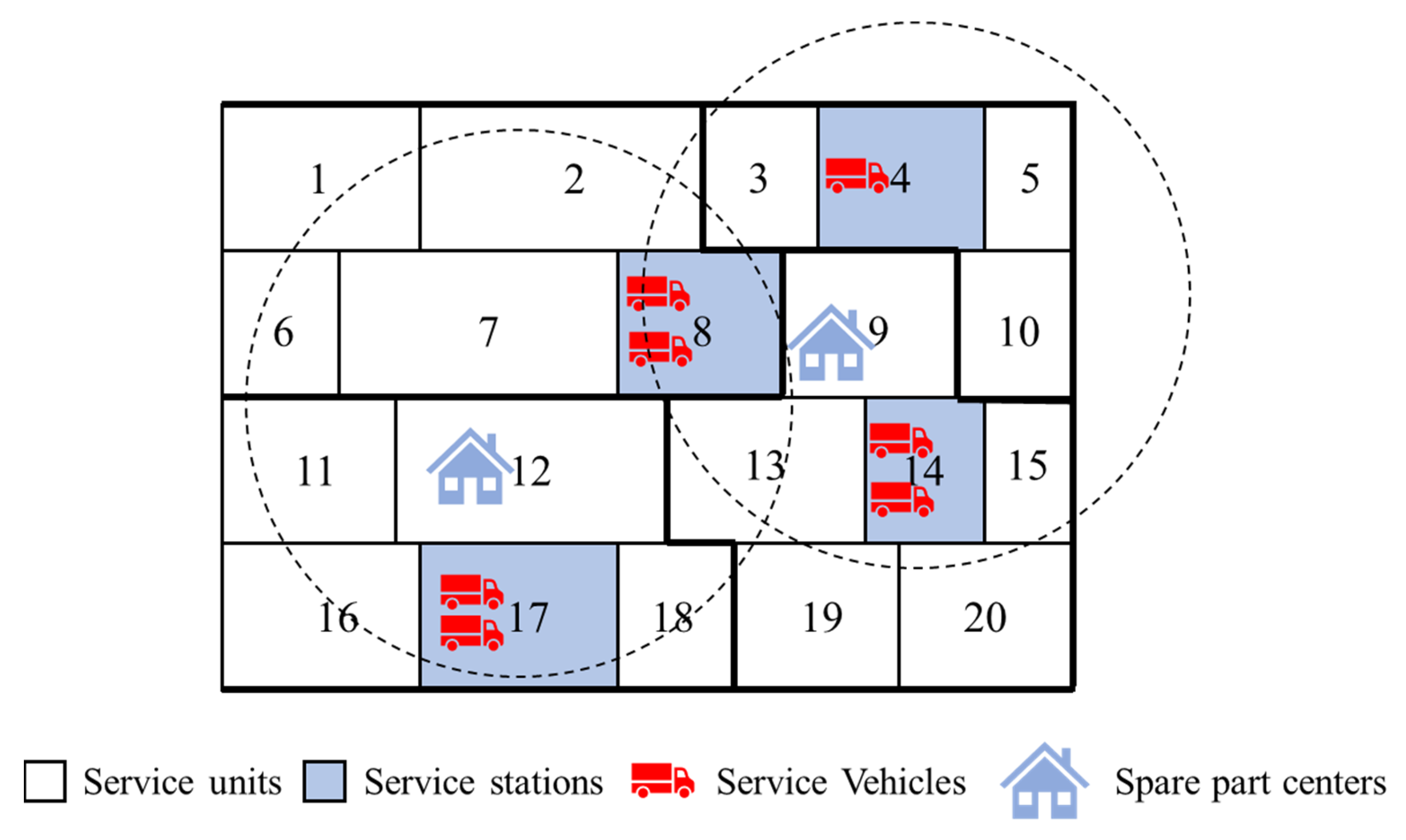


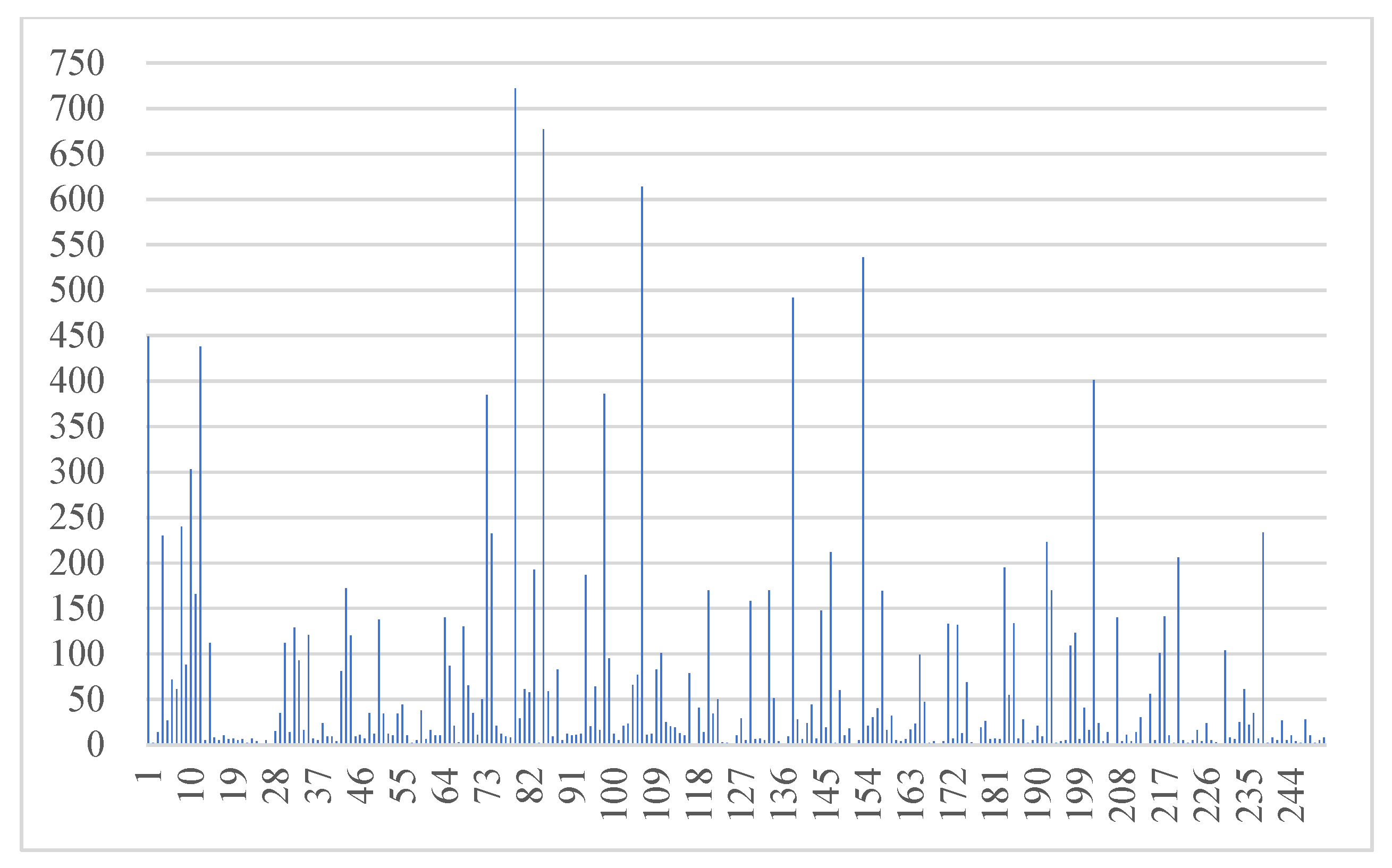
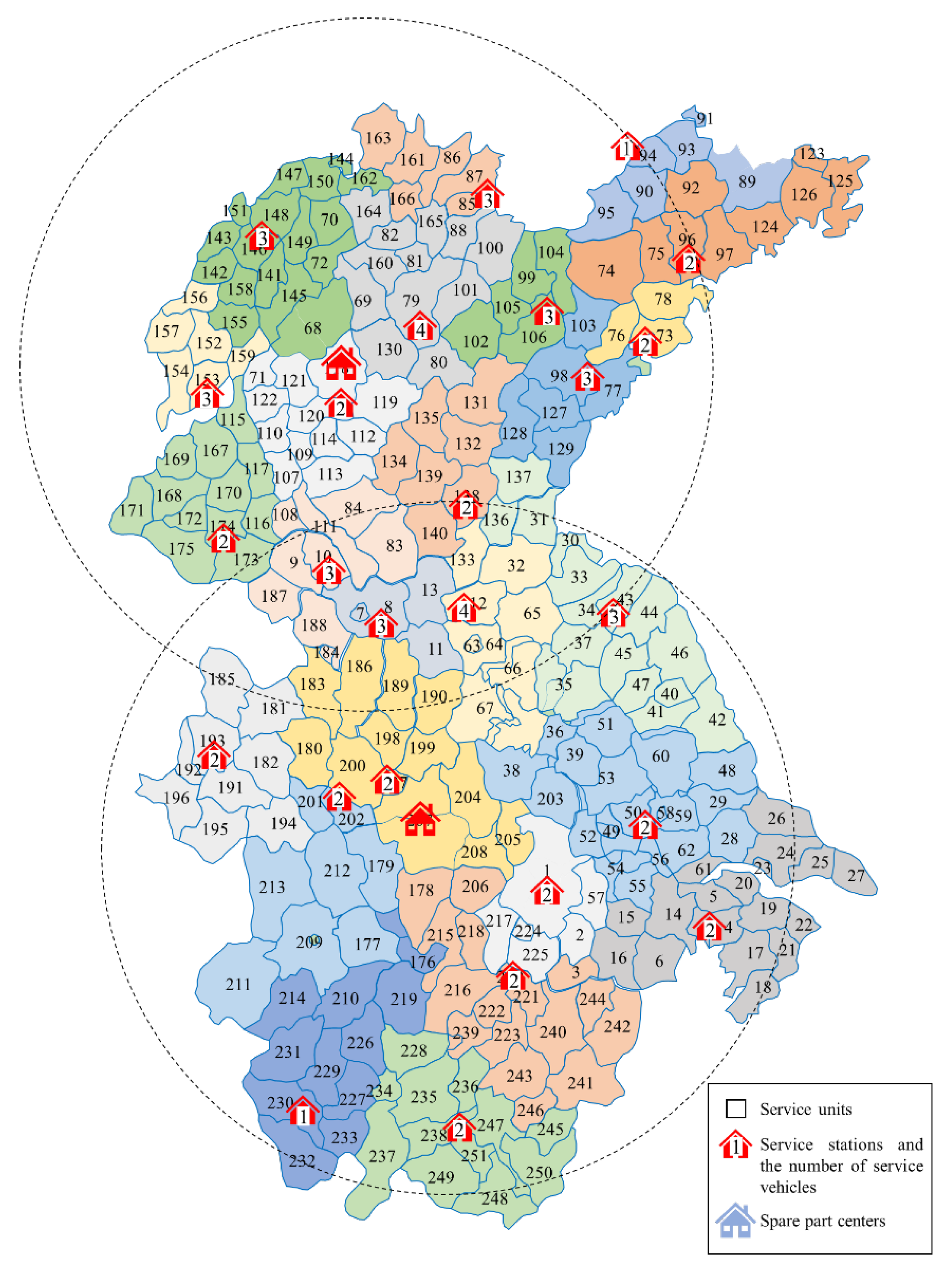
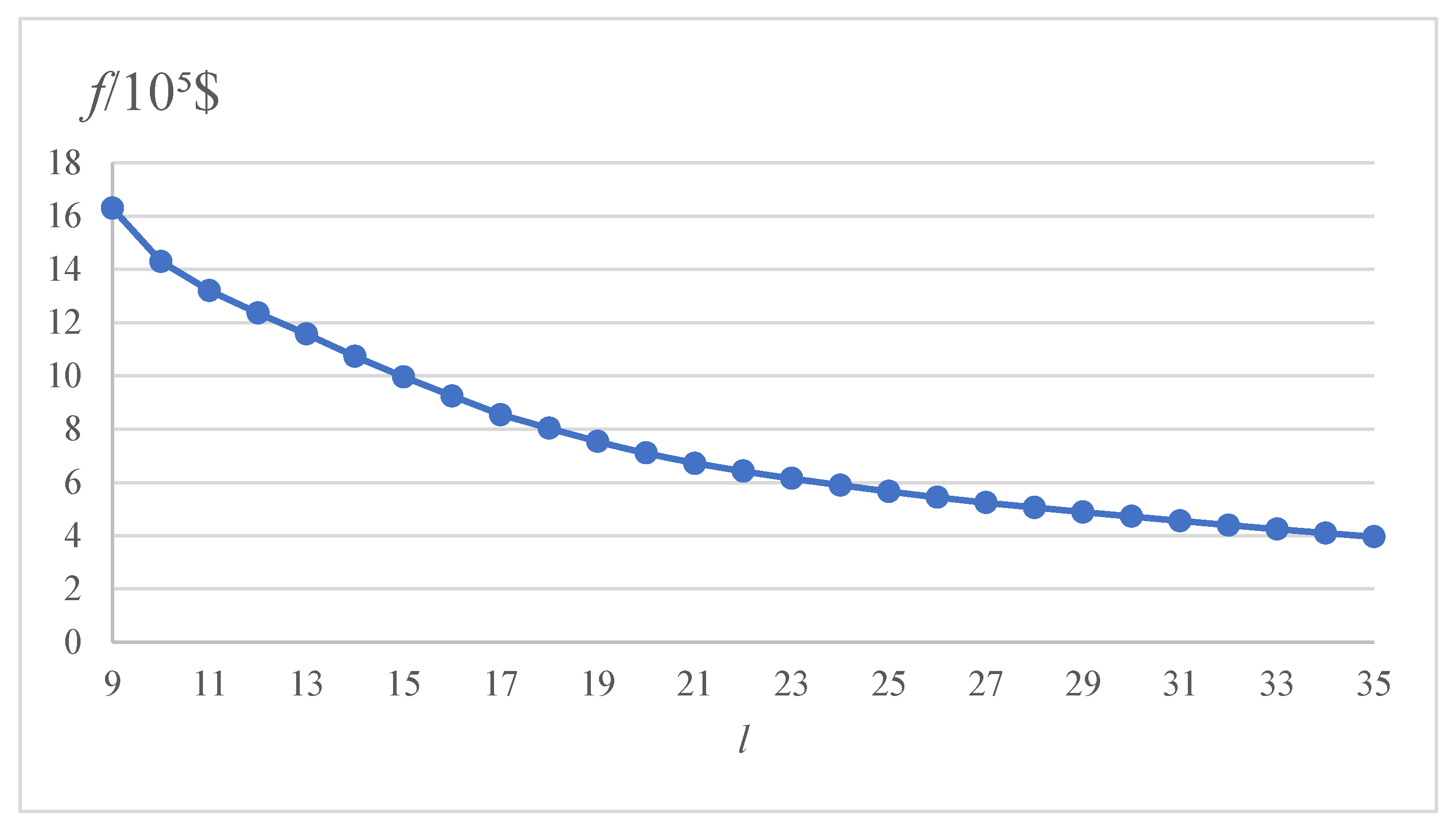
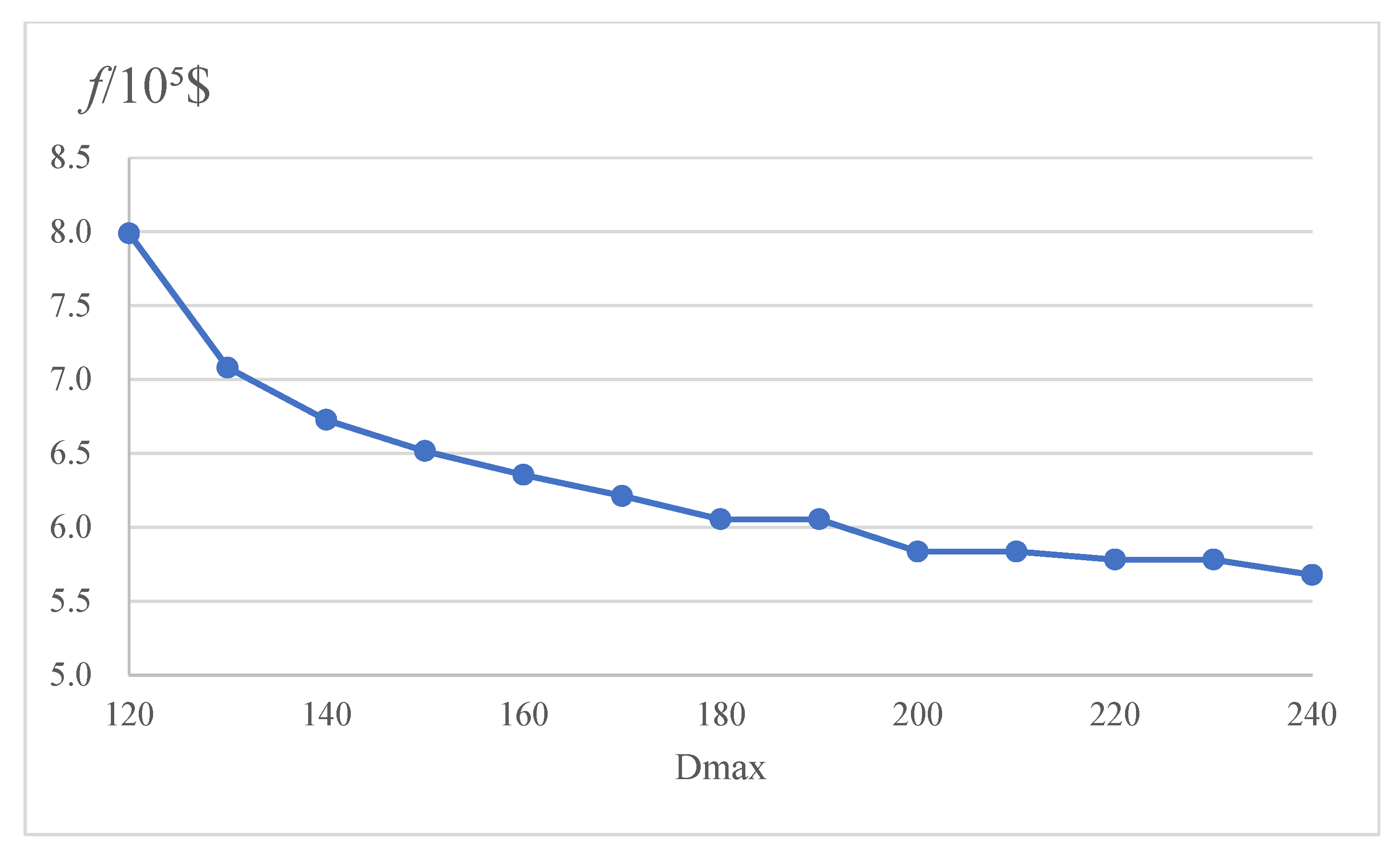
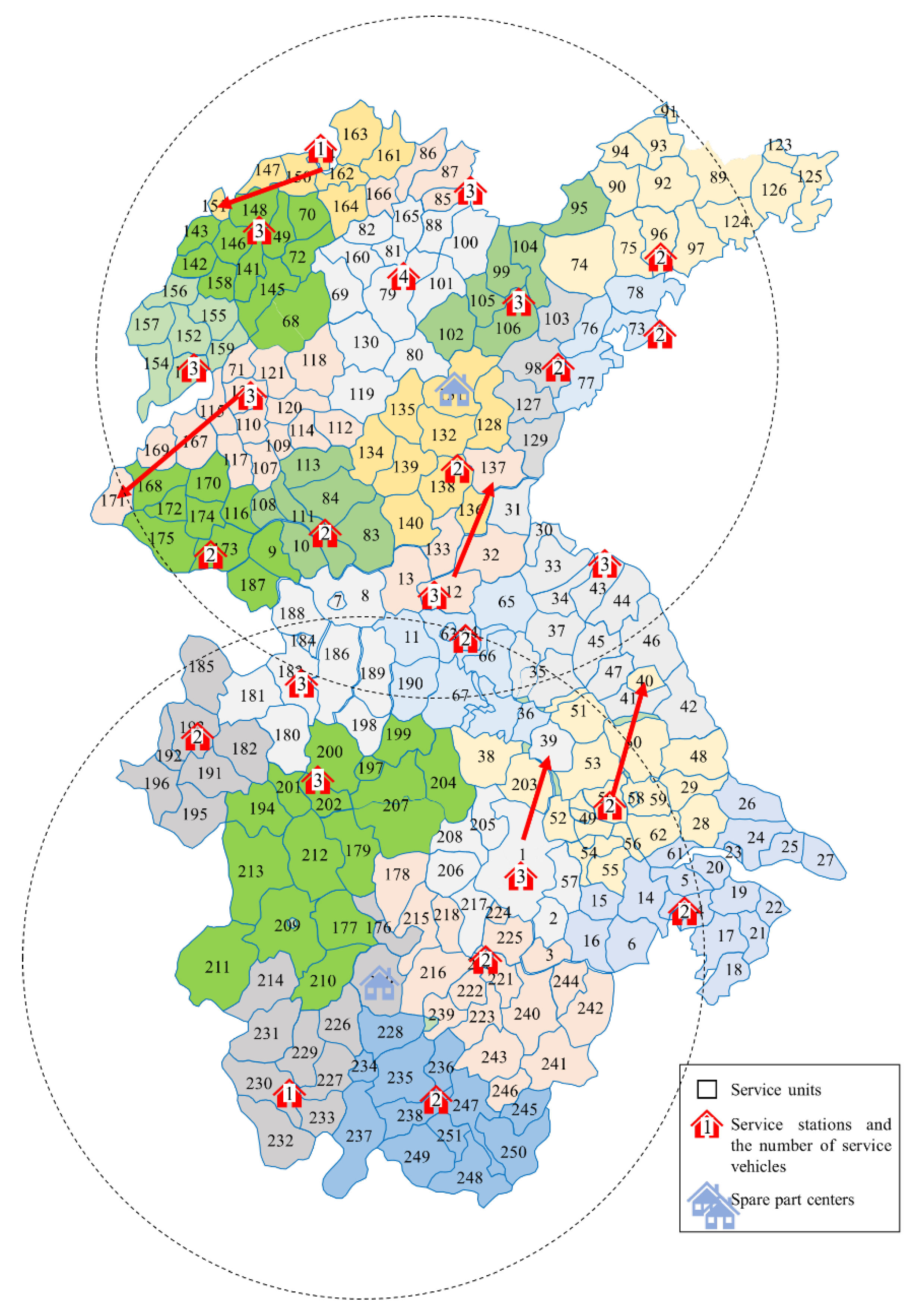

| NO. | Service Stations | Number of Vehicles | Service Units | Spare Part Centres |
|---|---|---|---|---|
| 1 | 1 | 2 | 1, 2, 57, 217, 224, 225 | 207 |
| 2 | 4 | 2 | 4, 5, 6, 14, 15, 16, 17, 18, 19, 20, 21, 22, 23, 24, 25, 26, 27, 61 | 207 |
| 3 | 8 | 3 | 7, 8, 11, 13 | 118, 207 |
| 4 | 10 | 3 | 9, 10, 83, 84, 108, 111, 184, 187, 188 | 118, 207 |
| 5 | 12 | 4 | 12, 32, 63, 64, 65, 66, 67, 113 | 118, 207 |
| 6 | 43 | 3 | 30, 31, 33, 34, 35, 37, 40, 41, 42, 43, 44, 45, 46, 47, 136, 137 | 118, 207 |
| 7 | 50 | 2 | 28, 29, 36, 38, 39, 40, 48, 49, 50, 51, 52, 53, 54, 55, 56, 58, 59, 60, 62, 203 | 207 |
| 8 | 73 | 2 | 73, 76, 78 | 118 |
| 9 | 79 | 4 | 69, 79, 80, 81, 82, 88, 100, 101, 130, 160, 164, 165 | 118 |
| 10 | 85 | 3 | 85, 86, 87, 161, 163, 166 | 118 |
| 11 | 94 | 1 | 89, 90, 91, 93, 94, 95 | 118 |
| 12 | 96 | 2 | 74, 75, 92, 96, 97, 123, 124, 125, 126 | 118 |
| 13 | 98 | 3 | 77, 98, 103, 127, 128, 129 | 118 |
| 14 | 106 | 3 | 99, 102, 104, 105, 106 | 118 |
| 15 | 120 | 2 | 71, 107, 109, 110, 112, 113, 114, 18, 119, 120, 121, 122 | 118 |
| 16 | 138 | 2 | 131, 132, 134, 135, 138, 139, 140 | 118, 207 |
| 17 | 146 | 3 | 68, 70, 72, 141, 142, 143, 144, 145, 146, 147, 148, 149, 150, 151, 155, 158 | 118 |
| 18 | 153 | 3 | 152, 153, 154, 156, 157, 159 | 118 |
| 19 | 174 | 2 | 115, 116, 117, 167, 168, 169, 171, 172, 173, 174, 175 | 118 |
| 20 | 193 | 2 | 181, 182, 185, 191, 192, 193, 195, 196 | 207 |
| 21 | 197 | 2 | 180, 183, 186, 189, 190, 197, 198, 199, 200, 204, 205, 207, 208 | 207 |
| 22 | 202 | 2 | 177, 179, 194, 201, 202, 209, 211, 212, 213 | 207 |
| 23 | 220 | 2 | 3, 178, 206, 215, 216, 218, 220, 221, 222, 223, 239, 240, 241, 242, 243, 244, 246 | 207 |
| 24 | 230 | 1 | 176, 210, 214, 219, 226, 227, 229, 230, 231, 232, 233 | 207 |
| 25 | 238 | 2 | 228, 234, 235, 236, 237, 238, 245, 247, 248, 249, 250, 251 | 207 |
| NO. | The Number of Service Units | The Number of Service Stations | Time_Gurobi/s | Time_Benders/s |
|---|---|---|---|---|
| 1 | 50 | 5 | 21.83 | 25.98 |
| 2 | 75 | 8 | 160.20 | 71.5 |
| 3 | 100 | 10 | 522.41 | 174.41 |
| 4 | 125 | 12 | 2333.45 | 1277.95 |
| 5 | 150 | 15 | 6329.20 | 499.09 |
| 6 | 175 | 17 | 52,400.61 | 781.06 |
| 7 | 200 | 20 | >12 h | 1635.64 |
| 8 | 225 | 25 | >12 h | 2006.72 |
| 9 | 250 | 30 | >24 h | 7682.50 |
Disclaimer/Publisher’s Note: The statements, opinions and data contained in all publications are solely those of the individual author(s) and contributor(s) and not of MDPI and/or the editor(s). MDPI and/or the editor(s) disclaim responsibility for any injury to people or property resulting from any ideas, methods, instructions or products referred to in the content. |
© 2023 by the authors. Licensee MDPI, Basel, Switzerland. This article is an open access article distributed under the terms and conditions of the Creative Commons Attribution (CC BY) license (https://creativecommons.org/licenses/by/4.0/).
Share and Cite
Li, J.; Ren, W.; Wang, X. Joint Location–Allocation Model for Multi-Level Maintenance Service Network in Agriculture. Appl. Sci. 2023, 13, 10167. https://doi.org/10.3390/app131810167
Li J, Ren W, Wang X. Joint Location–Allocation Model for Multi-Level Maintenance Service Network in Agriculture. Applied Sciences. 2023; 13(18):10167. https://doi.org/10.3390/app131810167
Chicago/Turabian StyleLi, Jinliang, Weibo Ren, and Xibin Wang. 2023. "Joint Location–Allocation Model for Multi-Level Maintenance Service Network in Agriculture" Applied Sciences 13, no. 18: 10167. https://doi.org/10.3390/app131810167





